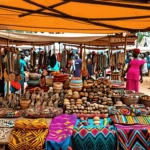Uhifadhi wa chakula ni mojawapo ya sanaa kongwe zaidi za wanadamu na mojawapo ya wasimulizi wake wa hadithi wenye nguvu zaidi. Nchini Norway, pepo za Aktiki zinazopita kwenye Visiwa vya Lofoten zimekausha chewa samaki wa samaki kwa zaidi ya miaka 1,000. Hung juu ya racks ya mbao na kuponywa na hewa baridi, samaki hukaa kwa miaka bila chumvi au friji, kuwa kujilimbikizia katika ladha na mnene katika protini.
Maelfu ya kilomita kutoka hapo, Waafrika pia walikuwa wakikausha, wakivuta, na kuwatia chumvi samaki muda mrefu kabla ya kuwasiliana na Ulaya. Tilapia iliyokaushwa kwa jua kwenye mwambao wa ziwa, bonga iliyopasuliwa na kutiwa chumvi kwa ajili ya masoko ya Afrika Magharibi, kambare waliofukuzwa kwa kuni zinazofuka moshi hizi hazikuwa mbinu za kuishi tu, bali ladha ambazo watu walikuja kuzipata. Ndiyo maana samaki wa samaki wa Kinorwe walipowasili kwa njia ya biashara katika karne ya 19, hawakutua kama mgeni. Lilikuwa ni wazo linalojulikana katika mfumo mpya: kuhifadhi kama ladha, kuishi kama kitamu.
Samaki Wapatana na Ustadi wa Kiafrika
Kufikia karne ya 19, samaki wa samaki walikuwa wakiingia Afrika Magharibi kwa kasi kupitia njia za biashara za Ulaya. Hadithi yake iliongezeka wakati wa Vita vya Biafra (1967-1970), wakati vizuizi vilisababisha njaa kusini mashariki mwa Nigeria. Samaki wa samaki wakawa protini ya maisha, na tangu wakati huo, imekunjwa kwa kina katika utambulisho wa upishi wa Nigeria.
Leo ni Nigeria mwagizaji mkubwa zaidi wa samaki wa Kinorwe, huku mamilioni ya kilo wakiwasili kila mwaka. Inajulikana ndani ya nchi kama okporoko kwa Kiigbo, ina umaarufu katika supu kama vile egusi, ogbono, na ofugbu (supu ya majani machungu). Kumhudumia mgeni samaki wa samaki wengi ni kuonyesha utajiri na ukarimu; majeshi wakati mwingine hujivunia juu ya ukubwa na upole wa vipande katika sufuria yao.
Katika Ghana, samaki wa samaki hurutubisha supu nyepesi za nyanya zinazoliwa na fufu. Katika Angola na Msumbiji, inachanganyika na pilipili za peri-peri, tui la nazi, na mafuta ya mawese, ikipatana na mila ya Kireno ya bacalhau na viungo vya Kiafrika. Katika Cape Verde, inaunganishwa moja kwa moja na Lusophone bacalhau lakini hubadilisha mihogo, maharagwe, au ndizi kwa viazi, na hivyo kuifanya sahani hiyo kuwa asilia. Katika Afrika Mashariki, samaki wa samaki walijiunga na kitoweo cha nazi na michuzi ya njugu, wakifaa kwa urahisi katika tamaduni za kuhifadhi ambazo tayari zilithamini tilapia au dagaa. Kuumwa kwake umami kutafuna kulivuma kwa kaakaa za kienyeji ambazo tayari zilijua uzuri wa samaki waliokaushwa.
Kwa Nini Stockfish Walijisikia Nyumbani katika Afrika
Sababu tatu zinaelezea kwa nini samaki wa samaki walistawi haraka sana:
- Resonance ya Uhifadhi - Waafrika walithamini kutafuna kwa moshi wa kambare waliokaushwa, kama vile watu wa Norway walivyothamini umami mwingi wa samaki wa samaki. Uhifadhi ulikuwa tayari umeunda ladha yenyewe.
- Umbile na Kina – Tafuna yake dhabiti na harufu nzuri iliendana na kitoweo cha mboga na wanga kama viazi vikuu, fufu, mihogo na wali.
- Alama ya Wingi - Zikiwa zimeagizwa kutoka nje na za gharama kubwa, samaki wa samaki wakawa kiungo cha hadhi - chakula cha harusi, sikukuu za Jumapili na sherehe.
Lishe & Hekima Vitendo
Samaki wa samaki sio ishara tu - ni moja ya vyakula vyenye virutubishi vingi ulimwenguni:
- 80% protini kwa uzito, pamoja na asidi zote muhimu za amino.
- Chini sana katika mafuta, na kuifanya kuwa konda lakini imejaa.
- Tajiri ndani vitamini B12, kalsiamu na chuma, kusaidia afya ya damu na uimara wa mifupa.
- Imehifadhiwa kwa asili bila viongeza - na inaweza kudumu miaka ikiwa imehifadhiwa kavu.
Waafrika pia walikuza hekima ya jikoni kuizunguka. Kuloweka samaki wa samaki katika maji ya joto (wakati mwingine kwa kumwagilia maziwa au soda ya kuoka) hulainisha haraka na kulainisha harufu yake kali. Vichwa na mifupa hutiwa ndani ya mchuzi, na kuhakikisha kuwa hakuna kitu kinachoharibika.
Kichocheo: Supu ya Naijeria ya Stockfish Egusi
Viungo
- Gramu 200 za samaki wa samaki (zilizowekwa usiku kucha ili kulainika)
- 200 g nyama ya ng'ombe au mbuzi (hiari)
- Kikombe 1 cha egusi (mbegu za melon)
- Kitunguu 1 cha kati (kilichokatwa)
- Nyanya 2 safi au kikombe 1 cha puree ya nyanya
- Vijiko 2 vya crayfish ya ardhini
- Pilipili 2-3 safi (au ladha)
- ½ kikombe mafuta ya mawese
- Vikombe 3 vya majani ya mchicha au ugu (zilizooshwa na kukatwakatwa)
- Vijiko 2 vya hisa au unga wa bouillon
- Chumvi kwa ladha
Mbinu
- Tayarisha samaki wa samaki: Loweka usiku kucha. Osha na ukate vipande vya ukubwa wa bite.
- Kupika nyama na samaki wa samaki: Katika sufuria kubwa, chemsha nyama ya ng'ombe/mbuzi na vitunguu, chumvi na vipande vya hisa hadi viive. Ongeza samaki na kaanga kwa dakika nyingine 10.
- Tengeneza kibandiko cha egusi: Changanya mbegu za tikitimaji zilizosagwa na maji kidogo ili kutengeneza unga mzito.
- Tengeneza supu: Pasha mafuta ya mawese kwenye sufuria, ongeza nyanya, vitunguu na pilipili. Fry mpaka harufu nzuri. Koroga unga wa egusi, ukipika kwa upole hadi utengeneze unene, nafaka.
- Unganisha: Ongeza mchanganyiko wa egusi uliokaanga kwenye sufuria na nyama na samaki wa samaki. Koroga vizuri.
- Ongeza kamba, rekebisha kitoweo na upike.
- Maliza: Ongeza majani ya mchicha/ugu na upike kwa muda mfupi hadi unyauke. Toa moto kwa viazi vikuu vilivyopondwa, fufu, au wali.
Tafakari ya Mwisho
Samaki wa samaki katika majiko ya Kiafrika ni zaidi ya kiungo; ni a upishi handshake hela hali ya hewa na karne. Kuanzia barafu ya Lofoten hadi masoko ya Lagos yenye shughuli nyingi, kutoka karamu za Cape Verde hadi curries za Msumbiji, inajumuisha ustahimilivu, urekebishaji, na kumbukumbu. Wanorwe na Waafrika walibadilisha ulazima kuwa ladha, na ladha kuwa utambulisho. Leo, kila chungu cha egusi, supu nyepesi, au kari ya nazi iliyokolea samaki wa samaki hubeba sio ladha tu, bali pia. historia uthibitisho kwamba uhifadhi sio tu kuishi, bali ni urithi wa pamoja.
Machapisho yanayohusiana
-
Masoko ya Afrika: Mahali pa Kununua Hazina Halisi, Zilizotengenezwa kwa mikono
Gundua masoko mahiri barani Afrika na ugundue hazina halisi, zilizotengenezwa kwa mikono kutoka Kente ya kifalme ya Ghana hadi Tuareg...
-
Equinor Hulipa Zaidi katika Ushuru kwa Afrika Kuliko Norway Hutoa kwa Msaada
Jumla ya misaada ya Norway kwa Afrika ni ndogo ikilinganishwa na kiasi kinacholipwa na serikali…
-
Maktaba Kubwa za Afrika - Zamani na Sasa
Kuanzia hazina za maandishi ya zamani hadi vituo vya kisasa vya kidijitali, maktaba za Kiafrika zimekuwa suluhu za…


